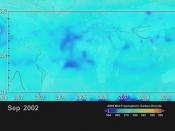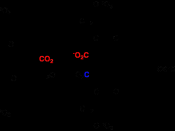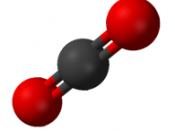The yield from an acid-carbonate reaction.
Introduction
Acids such as hydrochloric acid (HCl) react readily with carbonates to produce carbon dioxide gas. As the gas is released the mass of the reaction flask decreases. If the initial amount of carbonate (in this case sodium carbonate(Na2C03)) is known, then using the reacting ratios from the balanced equation of the reaction, it is possible to predict the mass of gas released (the yield).
Aim
In this activity students will learn that the amount of product from a chemical reaction can be determined, within the limits of experimental error. The mole concept is used to calculate the theoretical yield of carbon dioxide, which is in turn used to calculate the percentage efficiency of the reaction.
Procedure:
1. Accurately measure 20mls of 2 Molar HCl using a measuring cylinder. Transfer to a 100m1 conical flask.
2. Weigh the flask and it's contents. Record this weight.
3. Accurately measure between 0.9-1.0 g of sodium carbonate onto a watch glass. Record this weight.
4. Carefully transfer the contents of the watch glass to the conical flask, allowing the reaction to continue to completion. Gently swirl the flask during this time.
5. Reweigh the apparatus (conical flask and watch glass). Record these weights.
6. Establish the exact mass of sodium carbonate that reacted.
7. Write a balanced equation for the reaction of sodium carbonate and hydrochloric acid
8. Determine the moles of sodium carbonate reacted.
Determine the theoretical number of moles of carbon dioxide produced.
10. What mass of carbon dioxide does this represent?
11. How does this theoretical yield compare with the actual yield?
12. Account for any difference by reflecting on the accuracy of measurements and technique and considering the chemistry of the reaction products.
Results:
Item | Weight (g) | Uncertainties (g) | Observations |
Flask and contents | 90.650 | ñ0.001 | Balance display fluctuating in the third decimal place. The reading varies between 90.649 and 90.651. |
Watch glass | 19.217 | ñ0.001 | Balance display fluctuating in the third decimal place. The reading varies between 19.216 and 19.218. |
Watch glass with Na2CO3 | 20.128 | ñ0.001 | Some spillage on the balance plate |
Watch glass with Na2CO3 residue | 19.220 | ñ0.001 | Some spillage on the bench |
Flask and contents after the reaction | 91.257 | ñ0.001 | Some Na2CO3 stuck on the neck of the flask |
Data | Weight (g) | Uncertainties (g) | Observations |
Mass of Na2CO3 transferred | 0.908 | ñ0.001 + ñ 0.001 = ñ 0.002 | Upon transfer there was vigorous effervescence with some spitting, indicating there was a gas formed. Heat was generated and sizzling sound as well was produced. |
Total mass before the reaction | 110.778 | ñ0.001 + ñ 0.001 = ñ 0.002 | |
Total mass after the reaction | 110.477 | ñ0.001 + ñ 0.001 = ñ 0.002 | The flask was weighed when there was no visible bubbling. |
Mass of CO2 released | 0.301 | ñ0.002 + ñ 0.002 = ñ 0.004 |
The equation for the reaction examined in the experiment is:
Na2CO3 (s) + 2HCl (aq) ( CO2 (g) + H2O + 2NaCl
According to the equation, 1 mole of Na2CO3(s) will produce 1 mole of CO2(g).
Converting this to masses, 105.99 grams of Na2CO3(s) should produce 44.01 grams of CO2(g). In this experiment 0.908 grams of Na2CO3(s) produced 0.301 grams of CO2(g).
Calculation steps | Uncertainty Propagation | |
0.908 grams of Na2CO3(s) = 0.908g = 0.00857 moles ( rounded to 3 sif) 105.99g/mol | The uncertainty in 0.908g is ñ 0.002 = (ñ 0.002/0.894) x 100 = 0.22% | 0.22% |
The uncertainty in 105.99g/mol is ñ 0.01= (0.01/105.99) x 100 = 0.0000095% and so will be ignored. | - | |
Total uncertainty | 0.22% | |
According to the mole ratio demonstrated in the equation, 0.00857 moles of Na2CO3(s) should produce 0.00857 moles of CO2(g) | ||
0.00857 moles of CO2(g) = 0.00857mol x 44.01g/mol = 0.377g (3sf) | The uncertainty in 0.00857 moles of CO2(g) | 0.22% |
The uncertainty in 44.01g/mol is ñ 0.01 = (0.01/44.01) x 100 = 0.0000052% and so will be ignored | - | |
Final absolute uncertainty = (0.22/100) x 0.377 = 0.00083g | 0.00083g |
Theoretical yield of CO2 = 0.377g (3sf) ñ 0.001g. So 0.908g of Na2CO3(s) should have produced 0.377g (3sf) ñ 0.001g of CO2(g). The actual yield was 0.301g ñ 0.004g.
The result represents a percent yield of 0.301/0.377 x 100 = 79.8%, or an error of 100% - 79.8% = 20.2%
Discussion:
Conclusion
The percent yield of this experiment is 79.8%, indicating that the hypothesis has not been supported and this experiment is said to be relatively inefficient in terms of predicting the yield of carbon dioxide. The calculated random error is 0.22%, representing that the yield from this reaction is not within the limits of random experimental error. The percentage discrepancy shown by the result is 20.2%. Since mass is conserved in a chemical reaction and stoichiometry can be used to predict yields, this indicates the discrepancies in respect to systematic errors or mistakes.
Evaluation
As the genuine yield through experimentation is relatively less than expected, the systematic errors must be due to the reduction during reaction. However, there are also additional sources of random error that will be briefly discussed.
Errors | ||
Random Errors | Systematic errors | Mistakes |
This experiment includes random errors such as unreliable data due to the only trial being tested, fluctuation of the electronic balance and instrumental uncertainties. The processed data table has displayed all the uncertainty values. Additional random errors that may have been overlooked or underestimated may include: Extent of fluctuation of the balance The readings on the balance may show an extent of fluctuation over ñ0.001, such as ñ0.002, or even ñ0.003. Reading the electronic scales Electronic scales were not read consistently. This would result in a false estimation of the true value and data would be recorded imprecisely. Consideration of these additional random errors may account for a doubling or even tripling of the uncertainty to 0.66% but this is still a diminutive quantity of 20.2% discrepancy. | Systematic occurred during the experiment errors are listed below: Incomplete reaction of carbon dioxide An ideal of 100% reaction is impossible to be reached because not all carbon dioxide reacts. Thus the quantity of carbon dioxide produced (in gaseous state) would not be maximised. Also, it is difficult to determine whether a reaction is completed merely by observation. The reaction may be continued even if the solution is seemingly in a static state and weighing it before its completion would cause a shortfall in mass loss. However it would result in only about 2% of the errors since a very small amount of carbon dioxide does not react or continue to react. Solubility of CO2 As hydrogen oxide molecules are produced during the reaction, carbon dioxide, due to its good solubility, will dissolve in water and hence reducing the amount volatilised in the air. This is mostly likely the major cause in discrepancy which would possibly contribute 10%-15% of the errors. Electronic balance inaccuracy and inconsistency Faulty calibration of electronic balance may have led to inaccurate results. The true mass could be higher or lower than the display on the balance and this may account for approximately 1%-2% of the errors. | Mistakes occurred were recorded in the Raw Data Table. Most listed can be associated with a reduction in mass loss. Spillage of the sodium carbonate during weighing and transferring to the conical flask. The result affects an estimate of 1% of errors taking place. Sodium carbonate was not thoroughly transferred into the flask. For example, it sticked to the neck of the flask and will not react with hydrochloric acid. |
Improvements | ||
Random Errors | Systematic errors | Mistakes |
In order to reduce and minimise the Random Errors listed above, the following precautions can be taken: Extent of fluctuation of the balance Observe the display for a longer period of time and record the correct uncertainty until there is a stable extent of fluctuating data. Reading the electronic scales Since this error cannot be avoided but can only be minimised, several trials of reading should be taken and recorded, and the average reading should be calculated in order to increase the precision of the result. | The Systematic Errors can be rectified in the following way: Incomplete reaction of carbon dioxide This error can be theoretically corrected by increasing the concentration of hydrochloric acid to promote a more rapid and more violent reaction. Waiting for longer time for the reaction to complete is also suggested. Solubility of CO2 By increasing the temperature for this experiment, the solubility of carbon dioxide gas could be reduced and therefore the gas released could increase and thus providing a more accurate result. Electronic balance inaccuracy and inconsistency Changing the apparatus to ensure that the balance has not been damaged over time - would possibly avoid error. | To avoid the Mistakes in future experiments the following modifications can be made: A beaker and a funnel should be included in this experiment in order to prevent future mistakes because of sodium carbonate spillage. |
Bibliography:
http://www.creative-chemistry.org.uk/alevel/module1/documents/N-ch1-36.pdf
http://www.physics.umd.edu/courses/Phys276/Hill/Information/Notes/ErrorAnalysis.html
http://www.engineeringtoolbox.com/gases-solubility-water-d_1148.html
http://fcw.needham.k12.ma.us/~Janet/FOV1-00108AC5/Sodium%20carbonate%20lab.pdf
http://www.smc.edu/projects/28/Chemistry_10_Experiments/Ch10_Stoichiometry.pdf


